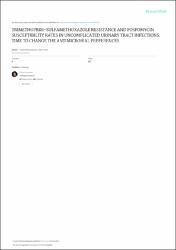| dc.contributor.author | Güneysel, Özlem | |
| dc.contributor.author | Suman, Enes | |
| dc.contributor.author | Öztürk, Tuba Cimilli | |
| dc.date.accessioned | 2020-12-19T19:55:37Z | |
| dc.date.available | 2020-12-19T19:55:37Z | |
| dc.date.issued | 2016 | |
| dc.identifier.citation | Guneysel, O., Suman, E., & Ozturk, T. C. (2016). Trimethoprim-sulfamethoxazole resistance and fosfomycin susceptibility rates in uncomplicated urinary tract infections: time to change the antimicrobial preferences. Acta clinica Croatica, 55(1), 49–57. https://doi.org/10.20471/acc.2016.55.01.8 | en_US |
| dc.identifier.issn | 0353-9466 | |
| dc.identifier.issn | 1333-9451 | |
| dc.identifier.uri | https://hdl.handle.net/11436/2563 | |
| dc.description | WOS: 000375890300008 | en_US |
| dc.description | PubMed: 27333718 | en_US |
| dc.description.abstract | Urinary tract infections (UTIs) are among the most common bacterial infections in adult population. They are prevalent in all age groups both in women and men. Also, UTIs are the most frequent indication for empirical antibiotic treatment in emergency department. the aim of this study was to determine the antibiotic resistance rates in the treatment of uncomplicated UTIs. Adult patients admitted to emergency department with uncomplicated UTIs were included in this cross-sectional study. Mid-stream urine samples were obtained under sterile conditions and cultured quantitatively. After 24 hours, the samples showing 10(5) colony forming unit per milliliter (CFU/mL) were tested for antibiotic susceptibility. Resistance to fosfomycin-trometamol (FT), amoxicillin-clavulanic acid (AC), ciprofloxacin (CIP), trimethoprim-sulfamethoxazole (TMP-SMX) and cefpodoxime (CEF) was tested by Kirby-Bauer disc diffusion system. Escherichia (E.) coli accounted for the vast majority (93.4%) of the organisms isolated in the study. Among the E. coli positive patients, resistance to TMP-SMX was the most common antibiotic resistance. the E. coli species detected in our study group were least resistant to FT (2.4%). the resistance rates, especially to CEF, AC and CIP, were significantly higher in patients over 50 years of age. in conclusion, in the treatment of uncomplicated UTIs, TMP-SMX should be excluded from empirical treatment, while fosfomycin could be a viable option in all age groups. | en_US |
| dc.language.iso | eng | en_US |
| dc.publisher | Sestre Milosrdnice Univ Hospital | en_US |
| dc.rights | info:eu-repo/semantics/openAccess | en_US |
| dc.subject | Urinary tract infections - drug therapy | en_US |
| dc.subject | Drug resistance, microbial | en_US |
| dc.subject | Fosfomycin - therapeutic use | en_US |
| dc.subject | Trimethoprim, sulfamethoxazole drug combination - therapeutic use | en_US |
| dc.subject | Emergencies | en_US |
| dc.title | Trimethoprim-sulfamethoxazole resistance and fosfomycin susceptibility rates in uncomplicated urinary tract infections: time to change the antimicrobial preferences | en_US |
| dc.type | article | en_US |
| dc.contributor.department | RTEÜ, Tıp Fakültesi, Cerrahi Tıp Bilimleri Bölümü | en_US |
| dc.contributor.institutionauthor | Suman, Enes | |
| dc.identifier.volume | 55 | en_US |
| dc.identifier.issue | 1 | en_US |
| dc.identifier.startpage | 49 | en_US |
| dc.identifier.endpage | 57 | en_US |
| dc.ri.edit | oa | en_US |
| dc.relation.journal | Acta Clinica Croatica | en_US |
| dc.relation.publicationcategory | Makale - Uluslararası Hakemli Dergi - Kurum Öğretim Elemanı | en_US |


















